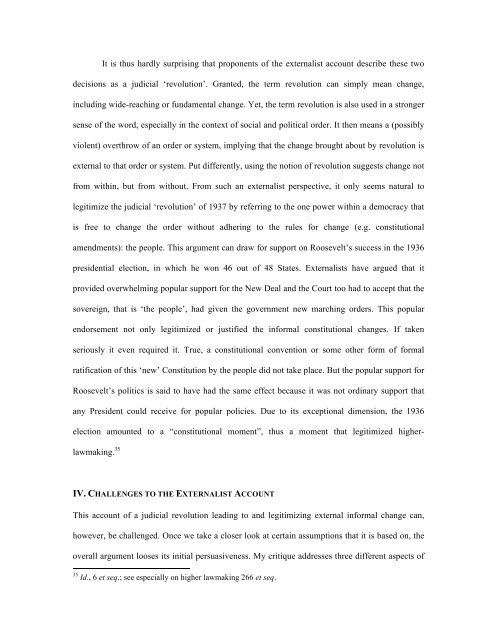Jasper Finke, Crisis and Law - New York University School of Law
Jasper Finke, Crisis and Law - New York University School of Law
Jasper Finke, Crisis and Law - New York University School of Law
Create successful ePaper yourself
Turn your PDF publications into a flip-book with our unique Google optimized e-Paper software.
It is thus hardly surprising that proponents <strong>of</strong> the externalist account describe these two<br />
decisions as a judicial ‘revolution’. Granted, the term revolution can simply mean change,<br />
including wide-reaching or fundamental change. Yet, the term revolution is also used in a stronger<br />
sense <strong>of</strong> the word, especially in the context <strong>of</strong> social <strong>and</strong> political order. It then means a (possibly<br />
violent) overthrow <strong>of</strong> an order or system, implying that the change brought about by revolution is<br />
external to that order or system. Put differently, using the notion <strong>of</strong> revolution suggests change not<br />
from within, but from without. From such an externalist perspective, it only seems natural to<br />
legitimize the judicial ‘revolution’ <strong>of</strong> 1937 by referring to the one power within a democracy that<br />
is free to change the order without adhering to the rules for change (e.g. constitutional<br />
amendments): the people. This argument can draw for support on Roosevelt’s success in the 1936<br />
presidential election, in which he won 46 out <strong>of</strong> 48 States. Externalists have argued that it<br />
provided overwhelming popular support for the <strong>New</strong> Deal <strong>and</strong> the Court too had to accept that the<br />
sovereign, that is ‘the people’, had given the government new marching orders. This popular<br />
endorsement not only legitimized or justified the informal constitutional changes. If taken<br />
seriously it even required it. True, a constitutional convention or some other form <strong>of</strong> formal<br />
ratification <strong>of</strong> this ‘new’ Constitution by the people did not take place. But the popular support for<br />
Roosevelt’s politics is said to have had the same effect because it was not ordinary support that<br />
any President could receive for popular policies. Due to its exceptional dimension, the 1936<br />
election amounted to a “constitutional moment”, thus a moment that legitimized higher-<br />
lawmaking. 35<br />
IV. CHALLENGES TO THE EXTERNALIST ACCOUNT<br />
This account <strong>of</strong> a judicial revolution leading to <strong>and</strong> legitimizing external informal change can,<br />
however, be challenged. Once we take a closer look at certain assumptions that it is based on, the<br />
overall argument looses its initial persuasiveness. My critique addresses three different aspects <strong>of</strong><br />
35 Id., 6 et seq.; see especially on higher lawmaking 266 et seq.
















